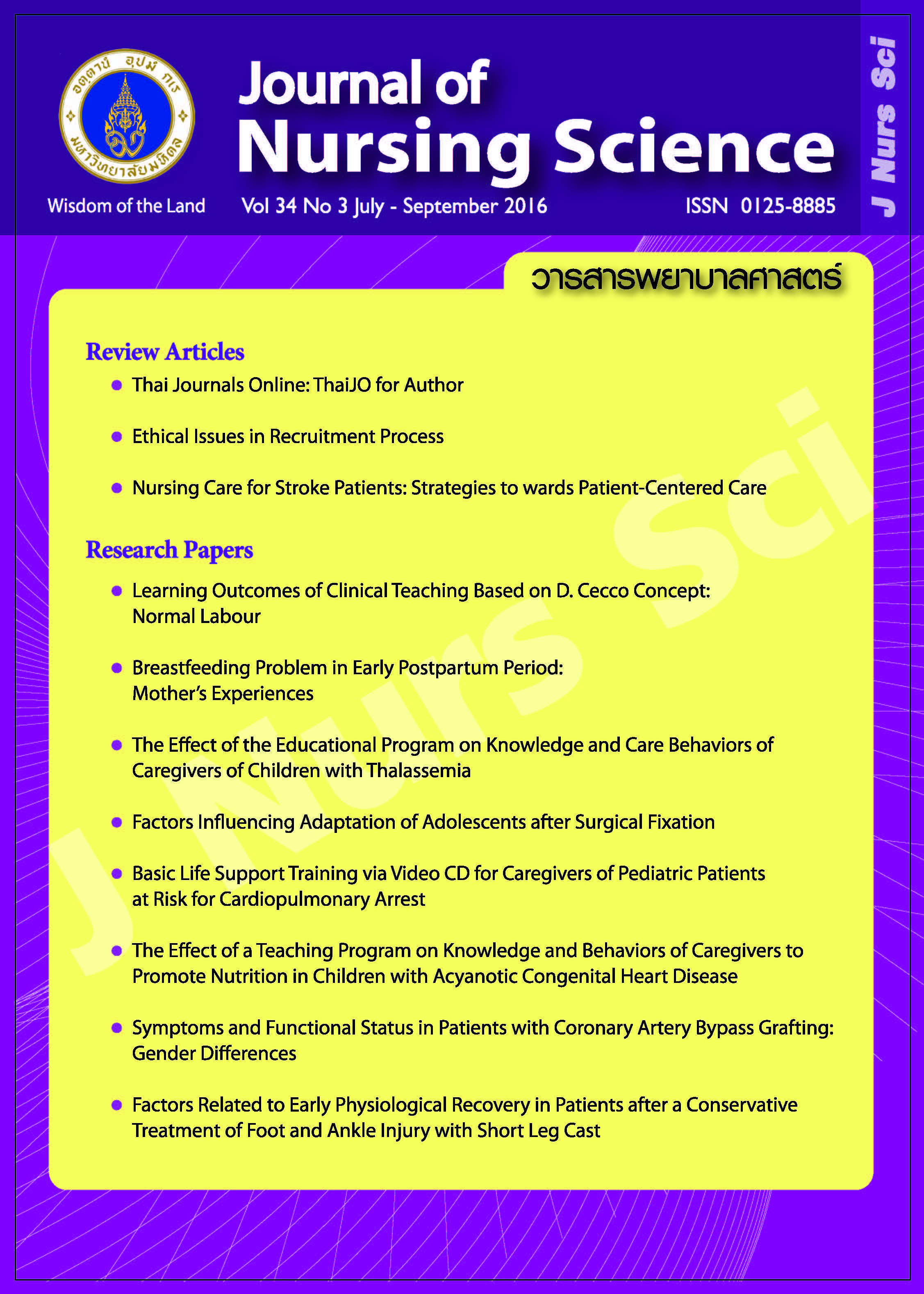Basic Life Support Training via Video CD for Caregivers of Pediatric Patients at Risk for Cardiopulmonary Arrest
Main Article Content
Abstract
Abstract
Purpose: The purpose of this experimental study was to compare two different basic life support training methods (including the use of VCD with self-instruction and VCD with nurse’s instruction) on knowledge and performance of cardiopulmonary resuscitation (CPR).
Design: Experimental research.
Methods: The study sample consisted of 64 primary caregivers of pediatric patients at risk for cardiopulmonary arrest who were admitted at pediatric wards in a university hospital. Data were collected using a demographic data interview form, the set of assessment forms about the knowledge of pediatric basic life support, practical skills in pediatric basic life support, and the learning of basic life support. Statistical analysis included descriptive statistics, analysis of covariance, t-test and, Fisher’s
exact test.
Main findings: The results revealed that the knowledge and overall performance of CPR between the group using VCD with self-instruction and the group using VCD with nurse’s instruction were not significantly different (p > .05). However, the group having a nurse to advise and coach their CPR skills demonstrated the essential skills of chest compression in terms of position and depth better than that of the group practicing by themselves.
Conclusion and recommendations: The findings suggest that basic life support training VCD should be encouraged for use in the training and also distributed to the learners, as it could be viewed at their convenient time. However, additional hands-on training for the essential CPR skills like chest compression is also needed to ensure the effectiveness of the training.
การสอนช่วยชีวิตขั้นพื้นฐานด้วยวีดิทัศน์สำหรับผู้ดูแลผู้ป่วยเด็กที่เสี่ยงต่อการเกิดภาวะหัวใจหยุดเต้น
บทคัดย่อ
วัตถุประสงค์: เพื่อเปรียบเทียบวิธีการสอนช่วยชีวิตเด็กขั้นพื้นฐานระหว่างการใช้วีดิทัศน์และฝึกปฏิบัติด้วยตนเองกับการใช้วีดิทัศน์และฝึกปฏิบัติกับพยาบาล ต่อความรู้และการปฏิบัติในการช่วยชีวิตเด็กขั้นพื้นฐานของผู้ดูแลผู้ป่วยเด็กที่เสี่ยงต่อการเกิดภาวะหัวใจหยุดเต้น
รูปแบบการวิจัย: การวิจัยเชิงทดลอง
วิธีดำเนินการวิจัย: กลุ่มตัวอย่างเป็นผู้ดูแลหลักของผู้ป่วยเด็กที่เสี่ยงต่อการเกิดภาวะหัวใจหยุดเต้น ที่หอผู้ป่วยเด็กในโรงพยาบาลมหาวิทยาลัยแห่งหนึ่ง จำนวน 64 คน เก็บข้อมูลโดยใช้แบบสัมภาษณ์ข้อมูลทั่วไป และแบบประเมินความรู้ในการช่วยชีวิตเด็กขั้นพื้นฐาน การปฏิบัติในการช่วยชีวิตเด็กขั้นพื้นฐาน และความคิดเห็นต่อการเรียนรู้ สถิติที่ใช้ในการวิเคราะห์ ได้แก่ สถิติเชิงพรรณนา การวิเคราะห์ความแปรปรวนร่วม การทดสอบที และการทดสอบฟิชเชอร์
ผลการวิจัย: ผู้ดูแลผู้ป่วยเด็กกลุ่มที่สอนด้วยวีดิทัศน์และฝึกปฏิบัติด้วยตนเอง และกลุ่มที่สอนด้วยวีดิทัศน์และฝึกปฏิบัติกับพยาบาล มีคะแนนความรู้ในการช่วยชีวิตเด็กขั้นพื้นฐานไม่แตกต่างกันอย่างมีนัยสำคัญทางสถิติ ภายหลังจากที่ควบคุมตัวแปรร่วม คือ คะแนนความรู้ก่อนการเรียน (F (1,61) = 1.14, p > .05) และภายหลังการสอน ผู้ดูแลทั้งสองกล่มุ มีความสามารถในการปฏิบัติการช่วยชีวิตเด็กขั้นพื้นฐานไม่แตกต่างกันอย่างมีนัยสำคัญทางสถิติ (p > .05) แต่กลุ่มได้ฝึกปฏิบัติกับพยาบาลมีค่าเฉลี่ยคะแนนการปฏิบัติรายข้อในเรื่องของตำแหน่งการวางมือ และความลึกขณะกดหน้าอก สูงกว่ากลุ่มที่ฝึกปฏิบัติด้วยตนเองอย่างมีนัยสำคัญ
สรุปและข้อเสนอแนะ: ควรส่งเสริมให้ใช้วีดิทัศน์ในการสอนช่วยชีวิตเด็กขั้นพื้นฐานและอาจมอบให้ผ้ดูแลด้วยเพื่อที่จะสามารถนำมาชมซํ้าเพื่อทบทวนความรู้และทักษะได้ตามสะดวก อย่างไรก็ตามการสอนอาจจำเป็นต้องมีพยาบาลเป็นผู้แนะนำและช่วยฝึกสำหรับทักษะที่สำคัญ เช่น ตำแหน่งและความลึกของการกดหน้าอก เพื่อประสิทธิผลของการสอน
คำสำคัญ : การสอนช่วยชีวิตขั้นพื้นฐาน การเกิดภาวะหัวใจหยุดเต้น ปฏิบัติการช่วยฟื้นคืนชีพ การสอนด้วยวิดีทัศน์ผู้ดูแล
Article Details
Copyright Notice: Nursing Science Journal of Thailand has exclusive rights to publish and distribute the manuscript and all contents therein. Without the journal’s permission, the dissemination of the manuscript in another journal or online, and the reproduction of the manuscript for non-educational purpose are prohibited.

Disclaimer: The opinion expressed and figures provided in this journal, NSJT, are the sole responsibility of the authors. The editorial board bears no responsibility in this regard.


